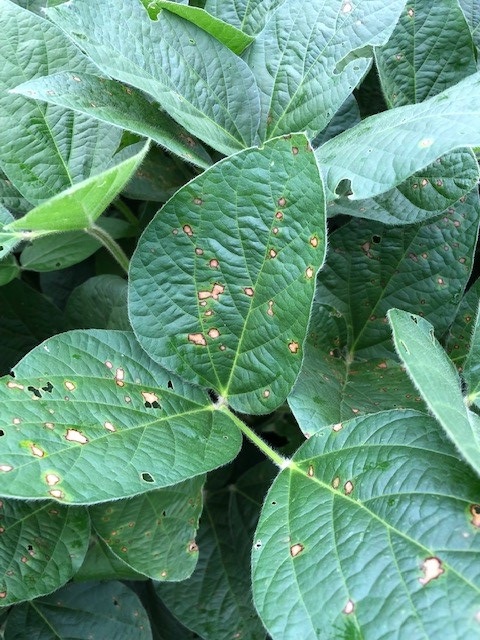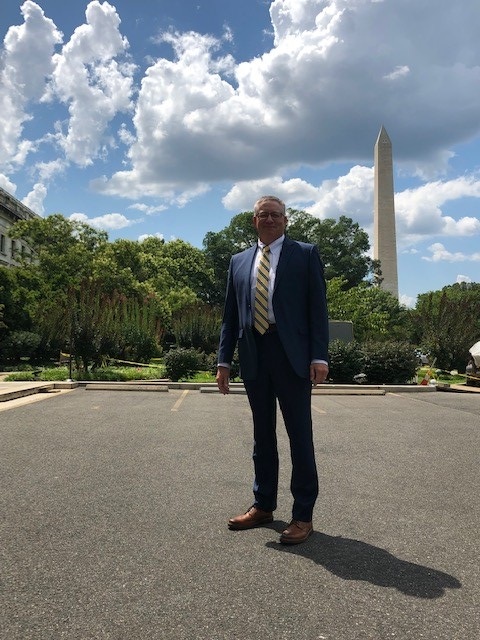Farm Life Journal - August 2019
August 8, 2019
By Tom Oswald
August is an in-between month. As I noted in last month’s Farm Life Journal, there are weeds to fight and crops to monitor, but there is also a lot of “wait and see” for non-irrigated soybean and corn crops right now. The weather has been pretty good for my crops other than a wind front a few weeks ago that caused some damage.
Sun and moisture drive rapid growth in corn – some say you can almost hear the corn grow! During the knee-high to tassel growth phase, the nodes, which are the points on the stem where leave emerge, of the plants are lush and brittle. After rapid growth, corn is susceptible to “brittle snap,” or breakage during high winds.
Once tasseled, the nodes (which look like finger joints) are less susceptible to snap because they get stringy from lignin formation, which somewhat “ties” things together. Farmers can select for hybrid varieties that are less likely to snap, but all corn hybrids have some risk or time window most susceptible to snapping.


If the plant breaks below the ear shoot, it’s not able to produce. A storm front that lasts only minutes can cause devastating levels of snap. I’ve seen fields where you could count the remaining stalks, not the broken stalks, because nearly all the plants were broken off. On July 4 last year, we had a storm front cause more than 40% of the plants to break off in areas of some hybrids. Fortunately, I didn’t have a lot of acres in that seed variety. Earlier this year, we had a strong storm front come through but our damage was fortunately was less than 5% (doesn’t happen every year).

One of the odd things is that you might have a few snapped plants in a row, then nothing broken off. Or you might have most of the plants in a row snapped. The susceptibility to snap can vary plant-to-plant, hybrid-to-hybrid in any given year. That’s why farmers manage how many hybrids we want to plant to manage risk for the various production issues that we face. In last month’s blog, I showed a photo of split-planter planted corn. Sometimes we can see 16 rows damaged, 16 rows hardly damaged when planted that way.
I take crop insurance for wind damage on corn, as well as hail insurance for both corn and soybeans (soybeans are seldom impacted by wind). This insurance is in addition to Federal Crop Insurance. We really don’t buy the insurance directly from the federal government, but there is an agency that administers the program. There is a sliding scale subsidy to encourage farmers to buy the insurance to manage risk. The highest levels of insurance aren’t subsidized, and there are some rules to follow to control fraud and manage land resources properly.
My dad and I have been buying crop insurance for decades. Storms happen. We often need storm fronts to provide rain in the summer as slow, soaking rain fronts are not that common. However, the financial damage a 20-minute storm can do could put a farmer out of business as the margins nowadays are so slim that self-insuring is too risky. Many farm operating loans are predicated on the farmer having crop insurance for risk management.
Other issues farmers look for this time of year are diseases and insects. The photo below shows a leaf disease in soybean known as frogeye leaf spot. Normally, this is not a big problem for me but is for my farmer friends in the South. Many plant diseases are a function of a susceptible host, a pathogen and an environment suitable for the disease to flourish.
I’m less concerned about certain pests because we can manage them with sprays or crop genetics that are resistant to the disease or insect. This genetic resistance can be created through natural breeding or biotechnology methods. However, other diseases simply kill the plant. There’s nothing more disheartening than watching a field die (can be in patches, plants or nearly in total) due to disease.

Genetic modification was happening long before Gregor Mendel began his observations on pea plant characteristics. How plant modification is accomplished is what changes over time, not the fact that biological creatures change. I am perfectly comfortable with modern genetic modification techniques because I have spent time with government regulators who oversee what practices are allowed, sold and used. These folks are serious scientists who go home to families just like everyone else. My comfort level in regulators’ desire for progress with safety runs HIGH.
With my service to the soybean industry, I’ve traveled to Washington D.C. several times. In July, not a lot of people like to wear a jacket and tie, but it’s part of the uniform for those of us who were there to discuss policy issues.
The photo to the left is from just outside the United State Department of Agriculture (USDA) building. Our group had just visited with various USDA leaders, including former Iowa Secretary of Agriculture Bill Northey. I’m standing 50 feet from Bill’s Chevy pickup still showing Polk County license plates. Bill and I studied at Iowa State University the same time. It’s fun to know people who are trying to do good things in government.
During the summer, most farmers like to trim their waterways and roadsides. But with the rain, it has been hard to keep up with mowing. The excess water has finally gone down, so I was able to mow a path to our pollinator plot. This is an area set aside and planted with grasses and plants to provide habitat for pollinator species.
Essentially, we rent a few acres of land to a government program, seed it and care for it under a defined set of practices. Plant diversity and a somewhat continuous stream of blooming plants helps the monarch butterfly and other insects flourish. We deliberately save some areas of milkweeds just to support the monarch. Other colors will dominate in the next days and weeks as the flowers come into bloom.

 On the horizon of the pollinator plot, you can see the new windfarm being built in our area. There are several opinions regarding whether high-quality Iowa farmland should be disturbed with wind towers. Our family chose not to sign up for easements or for a turbine site. For us, the notion of digging a hole and filling it with 50 truckloads of concrete didn’t fit with how we wish to treat our land. Yes, many things can be demolished once the useful life is over, but a chunk of concrete that big is likely to remain forever. Others may view that value point differently, and that’s fine, they will be paid well for a time. We hope we live far enough away to not be too annoyed with the sounds and pulsations. As someone with a bit of engineering interests, observing the windfarm construction has been interesting.
On the horizon of the pollinator plot, you can see the new windfarm being built in our area. There are several opinions regarding whether high-quality Iowa farmland should be disturbed with wind towers. Our family chose not to sign up for easements or for a turbine site. For us, the notion of digging a hole and filling it with 50 truckloads of concrete didn’t fit with how we wish to treat our land. Yes, many things can be demolished once the useful life is over, but a chunk of concrete that big is likely to remain forever. Others may view that value point differently, and that’s fine, they will be paid well for a time. We hope we live far enough away to not be too annoyed with the sounds and pulsations. As someone with a bit of engineering interests, observing the windfarm construction has been interesting.
One nice thing about August is that when there’s a break in the temperature and the wind isn’t blowing, we can sit on our west-facing patio. Sometimes the quiet is amazing – just the birds, crickets and cattle in pastures making their respective sounds. We can sometimes hear an airliner overhead. As travelers, we enjoy the air traffic. The sound isn’t too much to break the peaceful evening and it gives us a chance to wonder, “Who’s flying up there? Where they going? Are they curious about the countryside they are flying over?” In these moments, we like to pull up the Flight Aware app to see who is flying over our heads.
We look forward to more beautiful sunsets as temperatures cool further heading into fall. Between now and then, Susanne and I do a little personal traveling including attending the Iowa State Fair for a day. Our first date was at the Iowa State Fair in 1988, and since then, we have not missed a year… spending at least a few hours at the fair. In some cases, we’ve worked the Iowa Food & Family Project display or volunteered with other service projects. As tradition holds, we eat at least once at the beef and/or pork tents with a treat at the dairy barn for sure.
Till next time,
Tom